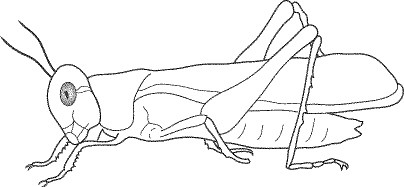True/False
Indicate whether the
statement is true or false.
|
|
|
1.
|
(1 point) Arthropod muscles are attached to the
outside of their skeleton.
|
|
|
2.
|
(1 point) The majority of insects undergo complete
metamorphosis.
|
Modified True/False
Indicate
whether the statement is true or false. If false, change the identified word or phrase to make
the statement true.
|
|
|
3.
|
(2 points) Crustaceans and arachnids are similar in
that they both have a cephalothorax and abdomen.
_________________________
|
Multiple Choice
Identify the
choice that best completes the statement or answers the question.
|
|
|
4.
|
(1 point) A student sees a picture of an arthropod
with two body sections and six pairs of jointed appendages. Which best describes the picture?
a. | an arachnid only | c. | an arachnid or an insect | b. | a crustacean
only | d. | an arachnid or a
crustacean |
|
|
|

Figure 26-1
|
|
|
5.
|
(1 point) Examine Figure 26-1. Which of the
following features does this insect share with all other insects?
a. | clawed feet | c. | three pairs of legs | b. | mandible | d. | wings |
|
|
|
6.
|
(1 point) Examine Figure 26-1. What type of life
cycle does this insect experience?
a. | complete metamorphoses | c. | alternation of generations | b. | incomplete
metamorphoses | d. | asexual life
cycle |
|
|
|
7.
|
(1 point) A scientist finds a new species of
arthropod. The arthropod has two sets of wings. To which of the following groups does this arthropod
most likely belong?
a. | arachnid | c. | insect | b. | crustacean | d. | It belongs in a new
group. |
|
|
|
8.
|
(1 point) How can a crustacean be differentiated
from an arachnid?
a. | All crustaceans have antennae, while arachnids have chelicerae. | b. | All crustaceans have
two body areas, while arachnids have three. | c. | All crustaceans have five pairs of legs, while
arachnids have four pairs. | d. | All crustaceans have hard exoskeletons, while
the exoskeletons of arachnids are soft. |
|
|
|
9.
|
(1 point) On a walk, a hiker finds an arthropod that
has more than six pairs of legs. The arthropod is feeding on a leaf. What type of arthropod did the
hiker most likely find?
a. | centipede | c. | millipede | b. | leafhopper | d. | tardigrade |
|
|
|
10.
|
(1 point) Adult insects often feed on different
plants than larvae of the same insect species. How is this advantageous?
a. | It allows the insects to feed on a wider range of foods. | b. | It causes the female
insect to travel further to deposit eggs. | c. | It permits larvae to develop in areas where the
adult insects cannot live. | d. | It decreases the chance of the larvae competing
with the adults for food. |
|
Completion
Complete each
statement.
|
|
|
11.
|
(2 points) A simple eye differs from a compound eye
in that a simple eye can only detect ____________________.
|
|
|
12.
|
(2 points) Insects that hatch from eggs as larvae
undergo ____________________ metamorphosis.
|
Short Answer
|
|
|
13.
|
(3 points) Compare and contrast simple eye
and compound eye.
|
|
|
14.
|
(2 points) When natural disasters strike natural
areas, often the only animals to survive are the insects. Explain why this might happen.
|
|
|
15.
|
(2 points) Insects have well-developed nervous
systems. How is this an adaptive advantage for insects?
|
|
|
16.
|
(2 points) Describe an insect that has adapted to a
windy, dry climate. Explain its adaptations.
|
|
|
17.
|
(2 points) It is believed that arthropods evolved
from the annelids. What differences, present in the arthropod structure, make arthropods better
adapted to their environment?
|
Essay
|
|
|
18.
|
(3 points) Write a short essay in which you examine
the advantages and disadvantages insects that live in societies have over other insects.
|
|
|
19.
|
(3 points) Between 70 and 85 percent of all known
animal species are arthropods. Write a short essay explaining which characteristics of arthropods
have made them so successful.
|